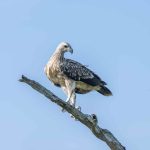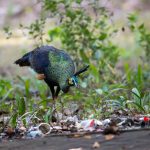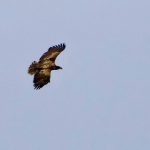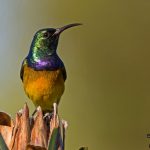Late winter, or second winter, or whatever you want to call it, continues its slow march into March. A week ago, a classmate eagerly told me about his sighting of an American Robin near his home. Spring, surely?
Of course, one Robin does not make a spring, and I told him about the hardy individuals who winter in the north, even in such a harsh north as this one. He took it in good spirits. But two days ago, this Debbie Downer got her comeuppance!
You see, as I walked across the park with Muir, my attention was drawn upwards by a large flock of birds coming in to settle in a mountain ash. It wasn’t the biggest flock I’d ever seen – murmurations of starlings still hold that honor. But these were no starlings. By the calls and profiles, I was quickly able to determine that the majority were Bohemian Waxwings, while the rest – still a significant portion, perhaps 30% – were American Robins. It was the most of either species I can remember seeing in one place, and they were hyped about the berries that the mountain ash still bore. A good thing about those berries, too, since the ground was still covered by not only a layer of fresh snow but also, in many spots, the crusty ice of previous freezes and thaws. Definitely not spring.
I haven’t lived in Montana long enough to feel jaded about Bohemian Waxwings, so I concentrated on them at first. But the Robins kept drawing my attention. They were less shy, took the lower positions in the tree. One buzzed me, barely a foot above my head. They bounced from one mountain ash to the next, and then on to other trees, and then for no reason I could see they rose up and flew away across the park towards the river.
So one Robin does not make a spring, but do one dozen? One score? One hundred? It turns out that flocks of that size are turning up in several locations in and around Missoula lately, and may not be that unusual for this time of year — at least, not in the brave new world of climate change.
Larry Weeks of the Five Valley Audubon Society points out that these are probably Robins destined for points north, not the one who will be singing and nesting and feeding young in the park this summer. Nevertheless, they seem to give a lot of people hope.
And who knows what signs of spring will turn up next?
Robin photo courtesy of the US Fish and Wildlife Service and Dr. Thomas G. Barnes














I have had a large flock of robins around my house for the past couple of weeks. This is very unusual in Chelmsford Ma, I can tell you that. We had our first real snowfall of the winter yesterday, and they were up in a tree near my holly bushes this morning. I made an effort to brush off as much of the snow and ice as I could, hoping to help them find the berries. they are very vulnerable in these bushes with snow cover though. I flushed a few individuals and felt terrible about it. I dumped some thistle on the ground near the tree. I wonder if they will eat it? Thanks for writing about this wonderful bird.
I live in Arkansas, Robins are plentiful here during the winter. Here in Arkansas Robins are not the harbinger of Spring as they are elsewhere.
I tend to regard robins on lawns as being a sign of spring. We sometimes have wintering flocks of over 10,000 robins, so robins in general are not a sign of spring, but their behavior changes as winter nears its end and they start feeding on lawns. Most years I see my first lawn robins within a few days of February 21. This year, despite the unwnterlike weather, I still haven’t seen them. I find that grackles are a better sign of spring than robins. They also show up at about that time.
During my Michigan year, the one avian sign of spring I valued the most was the return of the Red-winged Blackbirds, with their amazingly odd song. Here in Heidelberg, it is the return of the Red Kites.
But then again, spring isn’t spring, and there are so many different phases of spring that it really should be broken up into at least two separate seasons. Hmmmm, I wonder who’d be up to this daunting task?
Our first two Robin’s showed up two weeks ago as these two always do each year! Then about 4 days later, we are having 14 Robin’s in our yard. Every morning we check to see if the Robin’s are still with us, so far they are. We are from Central Illinois and do hope they all remain with us. Such a pretty bird, except when guarding their babies! HAPPY SPRING
For the last few days, we have been observing a lot of
Robins in our back yard. They are feeding, but I am not sure on what. We have lived on this property for about 14 years and have never observed that before.
The last few days HUNDREDS of robin are flocking in our yard. I’ve never seen them in these numbers before. They fly up and move from yard to yard…we live on an acreage..en mass. Very unusual and interesting. It seems there are fewer in the last day than the first., but still enough to scare the cats. Yes, that’s right. The cats are afraid of them and dart from window to window and then under the bed.